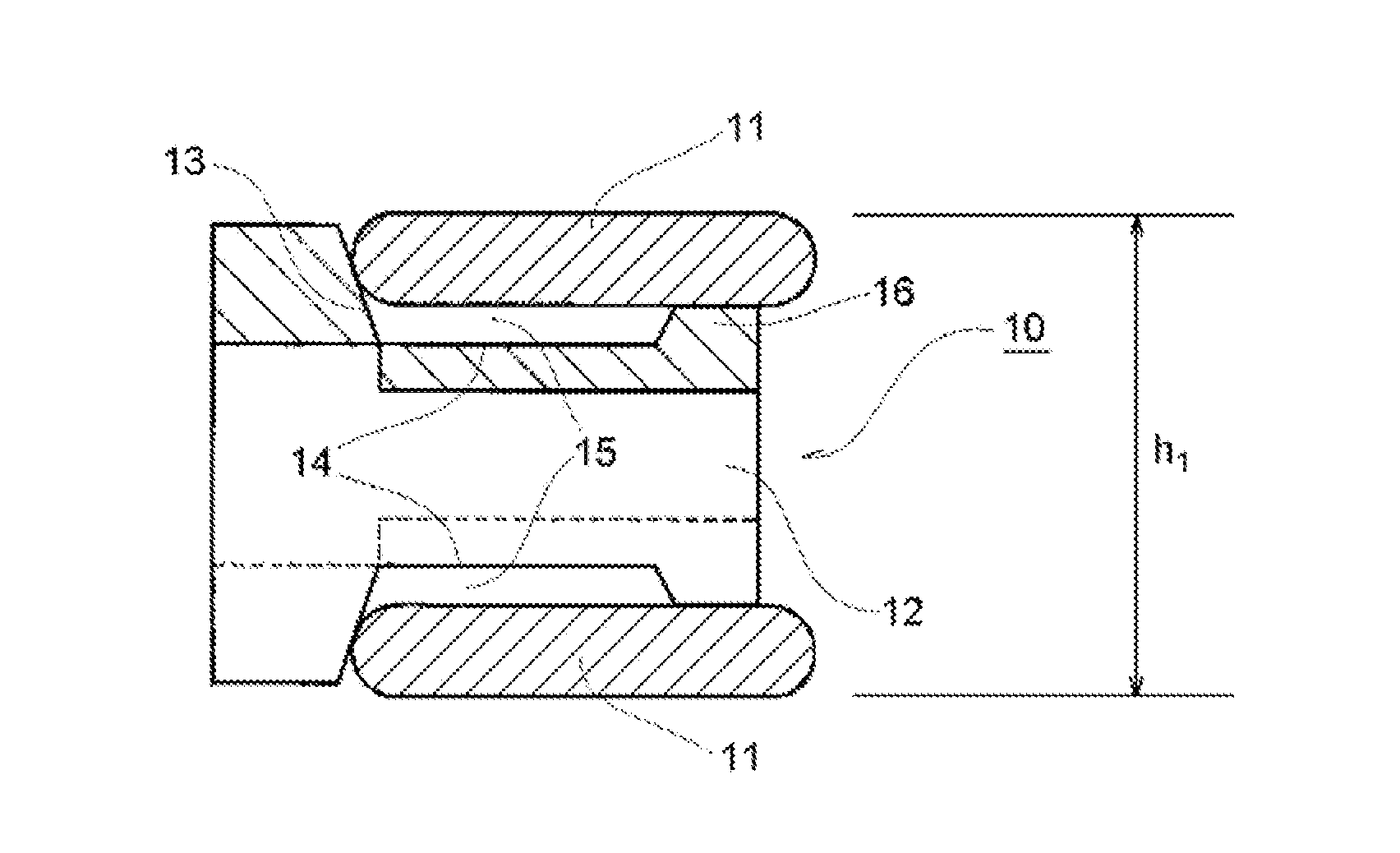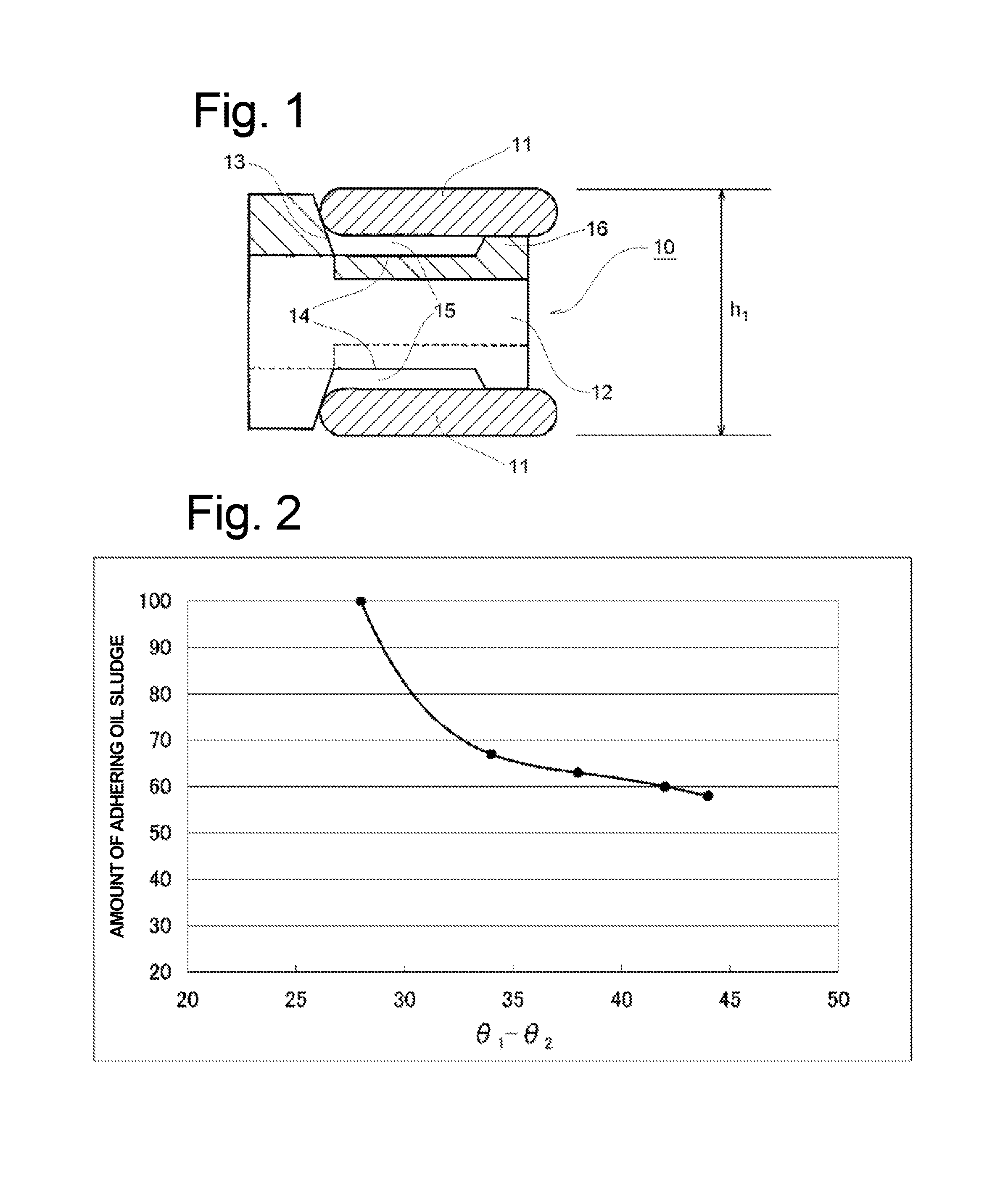Multi-piece oil ring
a multi-piece, oil ring technology, applied in the direction of brake systems, machines/engines, transportation and packaging, etc., can solve the problems of affecting the function of engine components such as oil rings, clogging of passages for lubricating oil, wear of components, etc., to achieve effective suppression of adhesion and deposition of oil sludge, prevent the occurrence of sticking of multi-piece oil ring, and large surface area
- Summary
- Abstract
- Description
- Claims
- Application Information
AI Technical Summary
Benefits of technology
Problems solved by technology
Method used
Image
Examples
example 1
(1) Production of Side Rails
[0059]A closed container was charged with respective monomers, a polymerization solvent, and a polymerization initiator in a mass ratio shown in TABLE 2, and the reaction was allowed to proceed at 70° C. for 26 hours to thereby obtain a polymerized composition. The polymerization initiator used was an initiator V-601 manufactured by Wako Pure Chemical Industries, Ltd., and the solvent used was metaxylene hexafluoride (m-XHF). The obtained polymerized composition was diluted with m-XHF such that the content of the polymer was 5% by mass to thereby obtain a coating solution. Side rails formed of 17Cr martensitic stainless steel were immersed in the coating solution for 30 seconds. After the side rails were removed from the solution, they were placed in an electric furnace and subjected to heat treatment in air at 120° C. for 1 hour. The angle of contact (θ1) of the paraffin-based lubricating oil with the side face portions of the obtained side rails at 150°...
example 2
(1) Production of Side Rails
[0064]Side rails were produced as in Example 1.
(2) Production of Spacer Expander
[0065]The surface of a rolled strip (made of SUS304) for a spacer expander that had an R-shaped edge was polished such that the line surface roughness Ra (center line average roughness) was 0.02 μm±0.01 μm and then degreased in acetone. While wound at a rate of 3 m / min, this rolled strip was subjected to Cu plating treatment using a wire plating apparatus in a plating bath containing 220 g / L of copper sulfate, 60 g / L of sulfuric acid, and 50 mg / L of chlorine ions. The thickness of the obtained Cu plating film was about 5 μm. After the plating treatment, the wire was placed in an electric furnace and subjected to heat treatment at 500° C. for 60 minutes.
[0066]Then the wire was gear-molded into an axially wavy shape. Then tabs were formed at one end portion of the wire by axial shearing and then molded and cut into a ring shape such that the tabs were on the inner peripheral sid...
example 3
(1) Production of Side Rails
[0068]A closed container was charged with respective monomers, a polymerization solvent, and a polymerization initiator in a mass ratio shown in TABLE 2, and the reaction was allowed to proceed at 70° C. for 26 hours to thereby obtain a polymerized composition. The polymerization initiator used was an initiator V-601 manufactured by Wako Pure Chemical Industries, Ltd., and the solvent used was metaxylene hexafluoride (m-XHF). The obtained polymerized composition was diluted with m-XHF such that the content of the polymer was 5% by mass to thereby obtain a coating solution. Side rails formed of 17Cr martensitic stainless steel were immersed in the coating solution for 30 seconds. After the side rails were removed from the solution, they were placed in an electric furnace and subjected to heat treatment in air at 120° C. for 1 hour. The angle of contact (θ1) of the paraffin-based lubricating oil with the side face portions of the obtained side rails at 150°...
PUM
 Login to View More
Login to View More Abstract
Description
Claims
Application Information
 Login to View More
Login to View More - R&D
- Intellectual Property
- Life Sciences
- Materials
- Tech Scout
- Unparalleled Data Quality
- Higher Quality Content
- 60% Fewer Hallucinations
Browse by: Latest US Patents, China's latest patents, Technical Efficacy Thesaurus, Application Domain, Technology Topic, Popular Technical Reports.
© 2025 PatSnap. All rights reserved.Legal|Privacy policy|Modern Slavery Act Transparency Statement|Sitemap|About US| Contact US: help@patsnap.com


